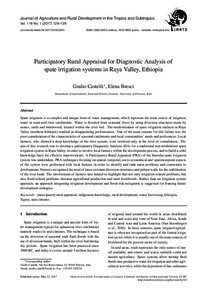| dc.date.accessioned | 2017-05-12T12:46:07Z | |
| dc.date.available | 2017-05-12T12:46:07Z | |
| dc.date.issued | 2017-05-12 | |
| dc.identifier.issn | 1612-9830 | |
| dc.identifier.issn | 2363-6033 | |
| dc.identifier.uri | urn:nbn:de:hebis:34-2017031552237 | |
| dc.identifier.uri | http://hdl.handle.net/123456789/2017031552237 | |
| dc.language.iso | eng | |
| dc.publisher | Kassel University Press | ger |
| dc.rights | Urheberrechtlich geschützt | |
| dc.rights.uri | https://rightsstatements.org/page/InC/1.0/ | |
| dc.subject | participatory rural appraisal | eng |
| dc.subject | indigenous knowledge | eng |
| dc.subject | rural development | eng |
| dc.subject | water harvesting | eng |
| dc.subject | Ethiopia | eng |
| dc.subject | Tigray | eng |
| dc.subject | arid climates | eng |
| dc.subject.ddc | 630 | |
| dc.title | Participatory Rural Appraisal for Diagnostic Analysis of spate irrigation systems in Raya Valley, Ethiopia | eng |
| dc.type | Aufsatz | |
| dcterms.abstract | Spate irrigation is a complex and unique form of water management, which represent the main source of irrigation water in semi-arid river catchments. Water is diverted from seasonal rivers by using diversion structures made by stones, earth and brushwood, located within the river bed. The modernisation of spate irrigation realised in Raya Valley (northern Ethiopia) resulted in disappointing performances. One of the main reasons for this failure was the poor consideration of the characteristics of seasonal catchments and local communities’ needs and preferences. Local farmers, who showed a deep knowledge of the river system, were involved only at the level of consultation. The aim of this research was to develop a participatory Diagnostic Analysis (DA) for a traditional non-modernised spate irrigation system in Raya Valley, in order to involve local farmers within the development process, and to build a solid knowledge basis for effective improvements. A Participatory Rural Appraisal (PRA) of the Harosha spate irrigation system was undertaken. PRA techniques focusing on spatial, temporal, socio-economical and spatiotemporal aspects of the system were performed with local farmers in order to identify and rank main problems and constraints to development. Farmers recognised the need of more resistant diversion structures and gabion walls for the stabilisation of the river bank. The involvement of farmers also helped to highlight that not only irrigation-related problems, but also flood-related problems threaten agricultural production and rural livelihoods. Rather than an irrigation system approach, an approach integrating irrigation development and flood risk mitigation is suggested for framing future development strategies. | eng |
| dcterms.accessRights | open access | |
| dcterms.bibliographicCitation | In: Journal of Agriculture and Rural Development in the Tropics and Subtropics. Kassel : Kassel University Press. - Vol. 118, No. 1 (2017) S. 129-139 | |
| dcterms.creator | Castelli, Giulio | |
| dcterms.creator | Bresci, Elena | |
| dc.description.everything | Gedruckte Ausg. im Verlag Kassel Univ. Press (www.upress.uni-kassel.de) erschienen. | ger |

